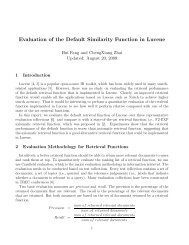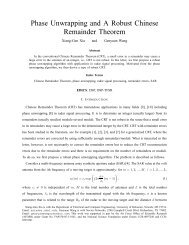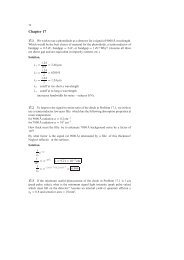Compressive Confocal Microscopy: 3D Reconstruction Algorithms
Compressive Confocal Microscopy: 3D Reconstruction Algorithms
Compressive Confocal Microscopy: 3D Reconstruction Algorithms
Create successful ePaper yourself
Turn your PDF publications into a flip-book with our unique Google optimized e-Paper software.
of the i-th slice within the <strong>3D</strong> data cube. The joint measurement matrix is defined as:<br />
⎡<br />
⎤<br />
W B 0 . . . 0<br />
0 W B . . . 0<br />
Φ = ⎢<br />
⎣<br />
.<br />
.<br />
. .. .<br />
⎥<br />
⎦ × P N 3 (9)<br />
0 0 . . . W B<br />
where W B represents a <strong>3D</strong> Hadamard transform operator for a BS × BS × BS volume and P N 3 is a pixelby-pixel<br />
<strong>3D</strong> permutation operator. The corresponding DMD pattern B m,n,k =P −1<br />
N<br />
Φ −1 Z m,n,k , where Z m,n,k is<br />
3<br />
a <strong>3D</strong> matrix with only one non-zero entry at the position (m, n, k). Since DMD is comprised by a 2D mirror<br />
array, we need to scan along the z-direction all the N slices in the DMD pattern B m,n,k to obtain one full <strong>3D</strong><br />
measurement. Although this method provides better reconstructed image quality than approach 1, the required<br />
image acquisition time is N times the acquisition time needed for 2D slice-by-slice reconstruction method. It is<br />
even more time-consuming than conventional CM. To overcome this limitation, an alternative <strong>3D</strong> reconstruction<br />
approach based on 2D measurement is proposed next.<br />
Approach 3: <strong>3D</strong> joint reconstruction from 2D measurement<br />
In approach 2, we measure the Hadamard coefficients of a permuted <strong>3D</strong> image F p = P N 3F . Now, we relax the<br />
requirement for the permutation operator. Instead of performing pixel-by-pixel permutation, we only permute<br />
the pixel within each slice. Define such operator as P s = {PN i }, i = 1, 2, · · · , N, with P i 2 N<br />
representing the<br />
2<br />
pixel-by-pixel permutation for the i-th slice. Then the joint measurement matrix is defined as:<br />
⎡<br />
⎤<br />
W B 0 . . . 0<br />
0 W B . . . 0<br />
Φ = ⎢ . .<br />
⎣<br />
.<br />
. . ..<br />
. ⎥<br />
. ⎦ × P s (10)<br />
0 0 . . . W B<br />
It will be shown shortly that, the projections of a <strong>3D</strong> image onto this joint measurement matrix could be<br />
obtained from a linear combination of 2D SBHE measurements of each single slice. For each slice, its 2D SBHE<br />
measurements are obtained with the DMD pattern defined in Eq. (8) using PN i as the permutation operator for<br />
2<br />
the i-th slice. Then, the <strong>3D</strong> measurements is obtained as follows.<br />
A <strong>3D</strong> Hadamard transform of a <strong>3D</strong> data cube F (x, y, z) is defined as:<br />
H(u, v, w) = 1 N<br />
N−1<br />
∑<br />
z=0<br />
N−1<br />
∑<br />
N−1<br />
∑<br />
x=0 y=0<br />
F (x, y, z)H(x, y, z, u, v, w) (11)<br />
where H(x, y, z, u, v, w) represents the transform kernel. Since Hadamard transforms are separable unitary<br />
transform, H can be written as H(x, y, z, u, v, w) = h(x, u)h(y, v)h(z, w), which means that Eq. (11) can be<br />
performed by first transforming each slice of F and then transforming each resultant array along the axial<br />
direction to obtain H. Formally,<br />
H(u, v, w) = 1 N<br />
N−1<br />
∑<br />
z=0<br />
N−1<br />
∑<br />
N−1<br />
∑<br />
x=0 y=0<br />
F (x, y, z)h(x, u)h(y, v)h(z, w) =<br />
N−1<br />
∑<br />
z=0<br />
F 2D (u, v, z)h(z, w), (12)<br />
where h represents an N × N binary Hadamard matrix, F 2D (u, v, z) represents the 2D Hadamard transform of<br />
the z-th slice. From Eq. (12), it can be seen that the <strong>3D</strong> Hadamard coefficients H(u, v, w) are just the linear<br />
combinations of 2D Hadamard coefficients F 2D (u, v, z) of different slices in this transformed image. To obtain the<br />
<strong>3D</strong> Hadamard domain measurements H(u, v, w), we just need to know the 2D Hadamard domain measurements<br />
F 2D (u, v, z) of all the N slices, z = 1, 2, . . . , N, which means that we need to sample at the position (u, v) of<br />
Hadamard domain for each slice. So the sampling positions in the 2D Hadamard domain for each slice should<br />
be the same. The randomness of the measurement matrix required by CS theory to maintain the incoherence<br />
between measurement matrix and sparse basis is conserved by using different permutation operators for different











